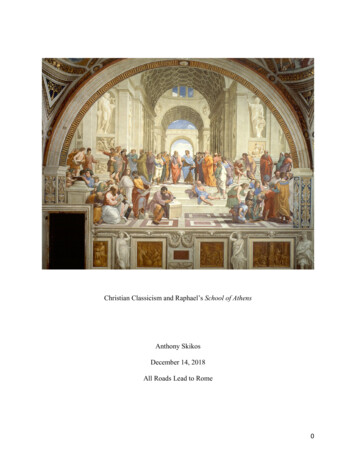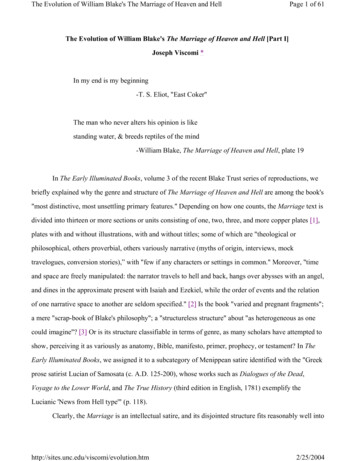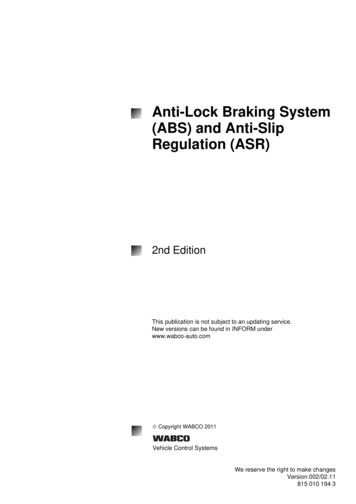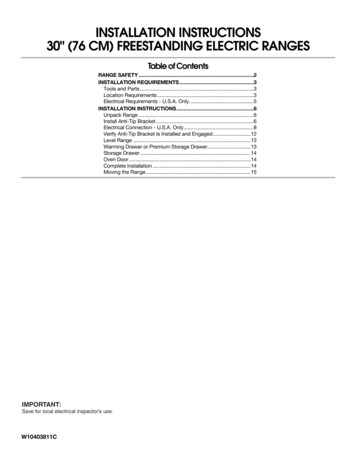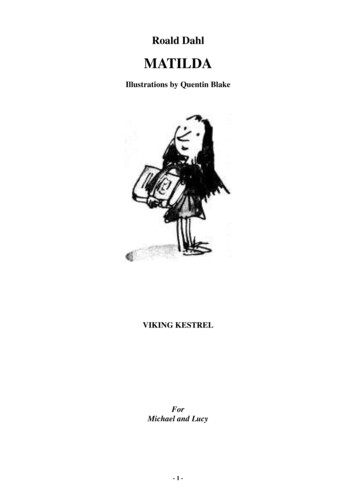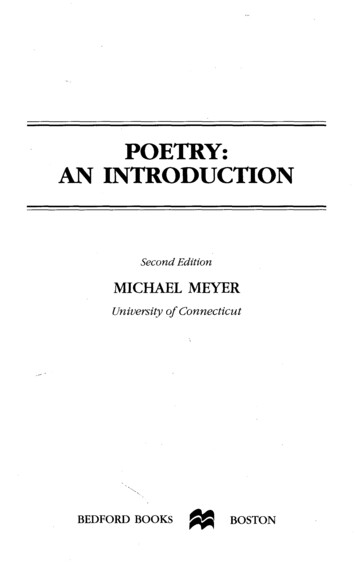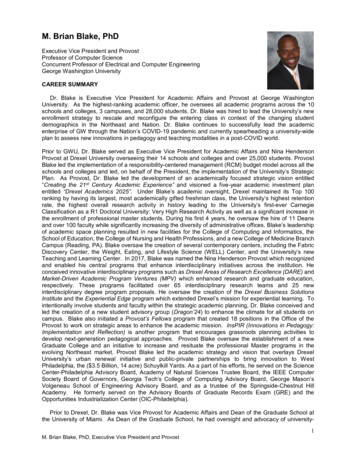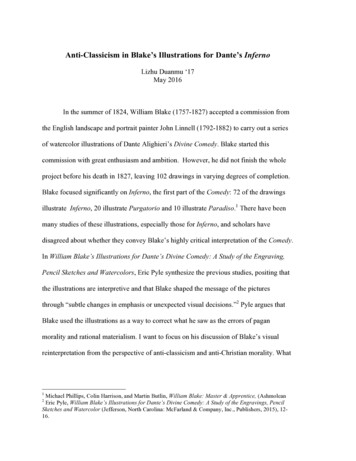
Transcription
Anti-Classicism in Blake’s Illustrations for Dante’s InfernoLizhu Duanmu ‘17May 2016In the summer of 1824, William Blake (1757-1827) accepted a commission fromthe English landscape and portrait painter John Linnell (1792-1882) to carry out a seriesof watercolor illustrations of Dante Alighieri’s Divine Comedy. Blake started thiscommission with great enthusiasm and ambition. However, he did not finish the wholeproject before his death in 1827, leaving 102 drawings in varying degrees of completion.Blake focused significantly on Inferno, the first part of the Comedy: 72 of the drawingsillustrate Inferno, 20 illustrate Purgatorio and 10 illustrate Paradiso.1 There have beenmany studies of these illustrations, especially those for Inferno, and scholars havedisagreed about whether they convey Blake’s highly critical interpretation of the Comedy.In William Blake’s Illustrations for Dante’s Divine Comedy: A Study of the Engraving,Pencil Sketches and Watercolors, Eric Pyle synthesize the previous studies, positing thatthe illustrations are interpretive and that Blake shaped the message of the picturesthrough “subtle changes in emphasis or unexpected visual decisions.”2 Pyle argues thatBlake used the illustrations as a way to correct what he saw as the errors of paganmorality and rational materialism. I want to focus on his discussion of Blake’s visualreinterpretation from the perspective of anti-classicism and anti-Christian morality. What1Michael Phillips, Colin Harrison, and Martin Butlin, William Blake: Master & Apprentice, (AshmoleanEric Pyle, William Blake’s Illustrations for Dante’s Divine Comedy: A Study of the Engravings, PencilSketches and Watercolor (Jefferson, North Carolina: McFarland & Company, Inc., Publishers, 2015), 1216.2
this paper will do is to examine and build on Pyle’s analysis, and to offer an alternativeaccount of the visual evidence in Blake’s images.Dante was born in Florence around 1265 and was well educated in Latin and theclassics.3 Actively involved in the political scene in Florence, Dante was accused ofcorruption and sentenced to exile by his political opponents who conspired with thePope.4 During his exile, Dante wrote the epic poem, Divine Comedy. As an imaginativepoem depicting the afterlife, the Comedy is firmly rooted in the classical, especially inVirgil’s Aeneid. Just as Virgil’s Aeneas descends to the underworld, so too the Comedydepicts Dante’s own allegorical pilgrimage through Hell, Purgatory, and finally up toHeaven. Dante’s attempt to transpose the classical world can be further seen in theparallelism between ancient and biblical figures in the Comedy.5 In most cases, a figurefrom Greco-Roman mythology can be found with its biblical or modern counterpart. Forexample, the ancient Greek mythological hero Jason and the Bolognese pandererVenedico Caccianemico were punished together for their sins of fraud.6 Dante rewroteand broadened Virgil’s Latin epic poem from the perspective of Christian epic in order tosurpass it.7 Superimposing Christian ideology on the Greco-Roman world, Dante has hispagan figures punished in the Christian Hell together with the modern figures. TheComedy was first fully translated into English by Henry Boyd, and then by Henry Francis3Barbara Reynolds, Dante: The Poet, the political thinker, the man (Emeryville, CA: Shoemaker & Hoard,an imprint of Avalon Publisher, 2006), 1-12.4James R. Lowell, “Dante,” in Annual Reports of the Dante Society, No. 5 (May 18, 1886, The JohnsHopkins University Press), 20-21.5Ernst R. Curtius, “Dante,” in European Literature and the Latin Middle Ages, (Princeton, NJ: PrincetonUniversity Press, 1983), 362.6Ronald R. Macdonald, The Burial-Place of Memory: Epic Underworlds in Vergil, Dante, and Milton(Amherst: The University of Massachusetts Press, 1987), 101.7Michelangelo Picone, “Dante and the classics,” in Dante: Contemporary Perspectives, edited byAmilcare A. Iannucci, (Toronto: University of Toronto Press, 1997), 61-67.2
Cary in the early nineteenth century. Blake consulted Cary’s translation when producinghis illustrations and he annotated Boyd’s introductory essays.8Even though we have Blake’s own writings and his comments on the Comedy, histhoughts are difficult to elucidate because of his opposition to both Christian morality andclassicism. In Blake’s antinomian theology, “God does not punish, and laws ofcondemnation are mistakes, attributable to the pre-Christian system of the fallen world,including the Greeks and those who follow Mosaic Law.”9 For Blake, the fall of man isnot caused by breaking God’s moral code, but by following the conventions and thusclosing up the possibility of perception and imagination. Blake’s anti-paganism comesfrom his belief in the Old Testament-based history that Hebrew culture was the origin ofGreco-Roman culture; Greco-Roman works of art were merely poor copies, and Greeksand Romans stole the ideas from the Hebrews.10 Following these two points, Pyle arguesthat the major disagreement between Dante and Blake is their attitude towards GrecoRoman classicism: the Comedy’s greatest debt to classicism is “the use of reason itself.”11In the opening of Blake’s article On Virgil, Blake regards the Aristotelian aesthetic in theclassical poem as harmfully reductive, and he claims that the classical poets “took infinitevision and reduced it to the level of their rationalistic understandings.”12 In Blake’s ownmythology, he ascribed this fallen condition - vision bounded by reason - to the false GodUrizen, who tried to dominate through conventional reason and law. By contrast, heviews the figure of Orc as rebellious and fighting with revolutionary force against the8Hazard Adams, Blake’s Margins: An Interpretive Study of the Annotations (Jefferson, North Carolina, andLondon: McFarland & Company, Inc., Publisher, 2009), 98.9Eric Pyle, William Blake’s Illustrations, 9.10Eric Pyle, William Blake’s Illustrations, 8.11Eric Pyle, William Blake’s Illustrations, 47.12Richey, William, Blake’s Altering Aesthetics, (Columbia, Missuori: University of Missouri Press, 1984),141-142.3
control of Urizen. In this way, although he still regarded Dante as a great poet, Blake’sown religious view was incompatible with the classicism and Christian moralityestablished in the Comedy.How, then, we might ask, would Blake execute the illustrations of the Comedy,whose ideology is rooted in classicism and Christian morality? Roe sees a “rewriting” ofDante’s Comedy into Blake’s own mythology. Pyle too thinks that Blake’s illustrationsvisually remake the mythology, transforming several scenes of punishment into scenes ofbrave revolution. “It is primarily in Dante’s final inability of manifest God that Blakesees a failure. [And] his illustrations then were not made to abolish the Comedy, but tofulfill it.”13 Blake replaced the God in Dante’s underworld with his own mythologicalcharacter Urizen, the false God responsible for the fallen world, and he depicted somesinners as playing the role of Orc, the rebellious protagonist fighting against theillegitimate dominant power.14According to Pyle, the illustration Capaneus the Blasphemer (Fig.1) is one of theimages that depicts the revolution set in motion by this defiant figure. However, I want tore-examine Pyle’s analysis because this part of his argument is not convincinglysupported by the visual evidence. I do not intend to argue that Pyle is necessarily wrongabout his analysis of Blake’s attitudes towards the Comedy, but I want to offer analternative visual analysis to challenge Pyle’s conclusions. While Pyle argues thatCapaneus’ imagery is an embodiment of rebellious force towards the power of reason, Iwant to suggest that the image shows a powerless and passive pagan hero.1314Eric Pyle, William Blake’s Illustrations, 2.Eric Pyle, William Blake’s Illustrations, 179-180.4
The illustration Capaneus the Blasphemer is a watercolor drawing and one of thefinished and most beautiful illustrations in the series.15 Capaneus is a minor figure inGreco-Roman mythology, and his story is told in Aeschylus’ The Seven Against Thebes,Euripides’ The Phoenissae, and Statius’ Thebaid. Capaneus, an earth-born giant withtremendous strength, was one of the seven kings who besieged the city of Thebes. Whenhe climbed up the ladder against the city wall of Thebes, Capaneus boasted that evenZeus was unable to stop him from conquering and destroying the city. As Capaneusmounted the ladder, Zeus smote him with a thunderbolt as punishment for hisarrogance.16 In the Inferno, Dante takes Capaneus out of the context of Greco-Romanmythology and condemns the pagan hero as an irreverent sinner in his Christian Hell. InDante’s Hell, Capaneus is punished as one of the blasphemers in the Seventh Circle: hissoul has to suffer eternal burning by huge flames incessantly falling from the sky.According to Dante’s account, unlike other desperate blasphemers, Capaneus “seems notto heed the fire, and lies disdainful and scowling, so that the rain seems not to ripenhim.”17 Having perceived that Dante is asking Virgil about him, Capaneus cries out,maintaining his disdain towards Zeus without any repentance:What I was living, that am I dead. Though Jove weary out his smith, from whom inanger he took the sharp bolt by which on my last day I was smitten; and though heweary out the others, turn by turn, in Mongibello at the black forge, crying ‘GoodVulcan, help, help!’ even as he did at the fight of Phlegra, and hurl at me with allhis might, he would not have thereby glad vengeance.1815Eric Pyle, William Blake’s Illustrations, 180.Euripides, The Phoenissae. Translated by E. P. Coleridge.17Dante Alighieri, The Divine Comedy: Inferno, trans., with a commentary, by Charles S. Singleton(Princeton, New Jersey: Princeton University Press, 1970), 143.18Dante Alighieri, The Divine Comedy, 145.165
If we compare the depictions of Capaneus in Greco-Roman mythology, this defiantpersonality remains the same, and in Dante’s Hell, Capaneus even retains his greatstrength to endure the burning torment.Pyle and others argue that Blake’s illustration visualizes Capaneus’ pride,obduracy, and physical strength. Milton Klonsky argues that Blake regarded Capaneuswith respect and admiration, which he claims is corroborated by Blake’s depiction ofCapaneus as a sanctioned defiant who did not deserve punishment: “Oblivious to thebolts of lightning. . .Capaneus gazes defiantly before him, reclining at his ease on thefiery sand as if it were the steam room of a Turkish bath. There is even the suggestion ofa halo about his head.”19 Albert S. Roe also describes Blake’s Canapeus as majestic andsinister, “oblivious to these torments and [staring] steadily and proudly before him.”20Expanding upon Klonsky and Roe’s visual analysis, Pyle pushes the conclusion furtherand sees the image as the transposition of Blake’s own myth onto Dante’s. Pyle arguesthat Blake’s portrayal of Capaneus glorifies him as an Orc-type revolutionary spiritpoised against the Urizen-type God of the Christian underworld. Admittedly, Klonsky,Roe, and Pyle reveal how Blake may interpret Dante’s Comedy according to his ownpersonal ideology. But I want to suggest that their analyses do not entirely correspondwith the visual evidence. Blake’s illustration of Capaneus actually shows a sense ofambivalence. Rather than a defiant figure retaining his force against the ‘false god,’Capaneus is depicted as a resigned pagan hero whose passivity is expressed by his facialexpression and body gestures.19Milton Klonsky, Blake’s Dante: The Complete Illustrations to the Divine Comedy (New York, NY:Harmony Books, a division of Crown Publishers, Inc, 1980), 143-144.20Albert S. Roe, Blake’s Illustrations to the Divine Comedy (Princeton, New Jersey: Princeton UniversityPress, 1953), 82-83.6
Blake’s Capaneus is significantly different from the loud and irritable figuredescribed by Dante and earlier poets because Blake’s Capaneus is more resigned andeven mournful. In the image, the two figures standing on the left are Virgil and Dante.Capaneus is the figure on the right, who occupies a large portion of the image. His facialexpression shows a sense of pain. Pyle describes Capaneus’ facial expressions as longsuffering as well. With his eyes looking up in vain and not in reassurance, he has a slightfrown and his eyebrows twist together, as if bearing a great deal of paint, but incapable ofspeaking out. Capaneus lies with his left leg on the ground in a reclining position. His leftarm supports his body and his right arm rests on his stretching right leg. He is surroundedby flames burning on the ground and he is struck by jagged thunderbolts from the above.With a straight neck, Capaneus looks up to the place where the flames descend. WhileCapaneus has a muscular body, his shoulders are drawn down, without any gesture,suggesting an attempt to get up. Although this pose can easily be read as relaxing orindifferent to the torment, I believe that the image actually shows his utter passivity whilereceiving his punishment, unable to stand up to take truly revolutionary actions. Pyle’sinterpretation of the flames is also untenable. Pyle argues that this image is a turningpoint and that Capaneus is the first in Blake’s underworld to retain revolutionary fireemanating from himself. The flames are therefore not flames of punishment, but flamesof passion provoking revolution.21 If we take a look at the previous plate, Dante andVirgil Among the Blasphemers (Fig. 2), there is also fire encircling the sinners, but Pyledoes not recognized their fire as “revolutionary.”Consider, too, the illustration for Inferno: Vanni Fucci “Making Figs” AgainstGod (Fig. 3). As we discussed before, the Comedy’s structure parallels both classical and21Eric Pyle, William Blake’s Illustrations, 180-181.7
Biblical sources. In Inferno’s text, there is an evident juxtaposition of Capaneus andVanni Fucci, who both defy the God. Capaneus defies a pagan God. I want to comparethe image of Vanni Fucci with the one of Capaneus. Capaneus is indeed depicted as arestrained figure compared to his counterpart, while both figures have the robust andmuscular body type.In the Comedy, Dante refers to Capaneus in his depiction of Vanni Fucci ofPistoia,22 who was a “violent partisan of the Neri in the blood-feud which raged in thatcity and [a thief] who in 1293 had plundered the treasury of San Jacopo in the church ofSan Zeno.”23 Fucci is also depicted as irreverent to God by making insulting gestures:At the end of his words the thief raised up his hands with both the figs, crying ‘Takethem, God, for I aim them at you!’.Ah, Pistoia, Pistoia! Why do you not decree toturn yourself to ashes and to last no longer, since you surpass your own seed in evildoing? Through all the dark circles of Hell I saw no spirit so proud against God, nothim who fell from the walls at Thebes.24With the last sentence, Dante makes a clear correlation between Fucci and Capaneus.Pyle also argues that Fucci is depicted as the Orc-type defiant figure, and, in this case, Ithink that the visual evidence supports his argument. Almost capable of escaping from hispunishments,25 Fucci’s heroic appearance is created by his straight posture, his vehementgesture, and his expressive facial expressions. Fucci is able to stand on his feet. Lookingup steadily, he raises his arms, making a profane hand gesture to the God above. He is notafraid or affected by the attacks from the serpents or the flames and thunderbolts from theabove. Compared with Capaneus, Fucci is a far better representative of the revolutionaryOrc. Virgil and Dante are also more engaged in this scene; their hand gestures show that22Alighieri Dante, The Inferno, trans. by Robert Hollander and Jean Hollander, introduction & Notes byRobert Hollander (New York, NY: Doubleday, 2000), 43223Albert S. Roe, Blake’s Illustrations to the Divine Comedy, 104.24Dante Alighieri, The Divine Comedy, 259.25Eric Pyle, William Blake’s Illustrations, 198.8
they are discomforted by Fucci’s highly inappropriate actions. By contrast, in theillustration of Capaneus, Virgil and Dante seem uninterested in the situation. Their blankfacial expressions detach them from any interaction with Capaneus, whereas in theComedy Virgil was irritated by Capaneus’ exacerbating words and cursed him back.26From the visual evidence, I want to suggest that Blake twists Dante’s parallelism ofCapaneus and Fucci, and Capaneus is specifically depicted as resigned to his punishmentfrom God in this Christian Hell.This interpretation sheds a different light on our understanding of Blake’s complexblend of theology, politics, and aesthetics in his illustrations for Dante’s Divine Comedy.Blake’s images convey more ambivalence than what he himself said about his thoughtson classicism and Christian morality. The problematic aspect of Pyle’s argument is thatan apparent contradiction in Blake’s attitude to paganism is ignored: why would Blakechoose a pagan hero as the catalyst for a revolution when he had a low opinion of GrecoRoman culture? The image itself shows contradictory visual elements. Capaneus ispunished by flames from God and thunderbolts from Jove. However, Dante does notmention Jove’s punishment in the Comedy at all, and the inclusion of the thunderbolt isBlake’s deliberate choice. It is therefore difficulty to determine which God Capaneusdefies. Do these images conflate anti-classicism with anti-Christian morality by breakingdown the schematic distinction between the classical underworld and the Christian Hell?It is difficult to answer this question with any certainty. However, I think that reading theimage in the context of Blake’s anti-classicism enriches our understanding of hisillustrations. Borrowing Roe’s argument about Blake’s work: “A vast storehouse of thethought of one of the most psychologically perceptive minds that the world has produced,26Dante Alighieri, The Divine Comedy, 145.9
it is as resistant to excavation as a diamond mine.” His last series, the illustrations for theDivine Comedy, is a riddle with intriguing clues, leaving many unanswered questions.Fig 1: William Blake, Capaneus the Blasphemer, watercolor, 1824-1827.10Fig 2: William Blake, Dante and Virgil Among the Blasphemers, watercolor, 1824-1827.
Fig 3: William Blake, Vanni Fucci “Making Figs” Against God, watercolor, 1824-1827.11
Works CitedAdams, Hazard. Blake’s Margins: An Interpretive Study of the Annotations. Jefferson,North Carolina, and London: McFarland & Company, Inc., Publisher, 2009.Alighieri, Dante. The Divine Comedy: Inferno. Translated, with a commentary, byCharles S. Singleton. Princeton, New Jersey: Princeton University Press, 1970.Alighieri, Dante. The Inferno. Translated by Robert Hollander and Jean Hollander.Introduction & Notes by Robert Hollander. New York, NY: Doubleday, 2000.Braida, Antonella. Dante and the Romantics. Houndmills, Basingstoke, Hampshire andNew York: Palgrave Macmillan, 2004.Curtius, Ernst R. “Dante.” In European Literature and the Latin Middle Ages. Princeton,NJ: Princeton University Press, 1983.Euripides. The Phoenissae. Translated by E. P. ssae.htmlKlonsky, Milton. Blake’s Dante: The Complete Illustrations to the Divine Comedy. NewYork, NY: Harmony Books, a division of Crown Publishers, Inc, 1980.Lowell, James R. “Dante.” In Annual Reports of the Dante Society, No. 5 (May 18, 1886,The Johns Hopkins University Press): 15-38.Macdonald, Ronald R. The Burial-Place of Memory: Epic Underworlds in Vergil,Dante, and Milton. Amherst: The University of Massachusetts Press, 1987.Phillips, Michael, Colin Harrison, and Martin Butlin. William Blake: Master &Apprentice. Ashmolean Museum, University of Oxford, 2014.Picone, Michelangelo. “Dante and the classics.” In Dante: Contemporary Perspectives,edited by Amilcare A. Iannucci. Toronto: University of Toronto Press, 1997.Pyle, Eric. William Blake’s Illustrations for Dante’s Divine Comedy: A Study of theEngravings, Pencil Sketches and Watercolors. Jefferson, North Carolina:McFarland & Company, Inc., Publishers, 2015.Reynolds, Barbara. Dante: The Poet, the political thinker, the man. Emeryville, CA:Shoemaker & Hoard, an imprint of Avalon Publisher, 2006.Richey, William. Blake’s Altering Aesthetics. Columbia, Missuori: University ofMissouri Press, 1984.Roe, Albert S. Blake’s Illustrations to the Divine Comedy. Princeton, New Jersey:Princeton University Press, 1953.12
depicts Dante's own allegorical pilgrimage through Hell, Purgatory, and finally up to Heaven. Dante's attempt to transpose the classical world can be further seen in the parallelism between ancient and biblical figures in the Comedy.5 In most cases, a figure from Greco-Roman mythology can be found with its biblical or modern counterpart. For
